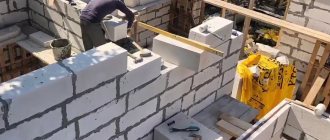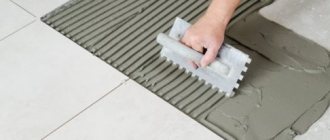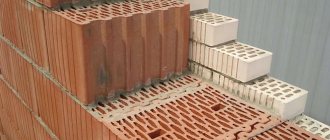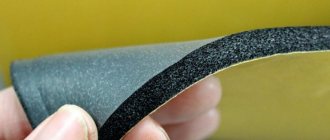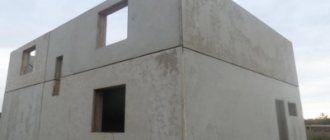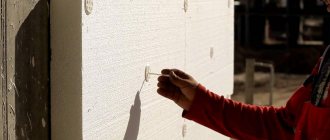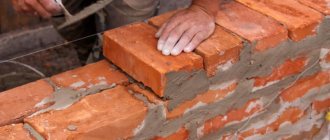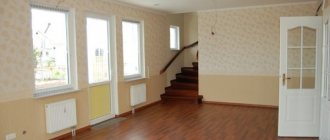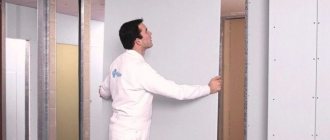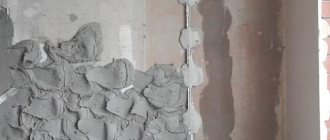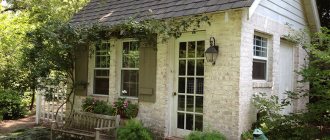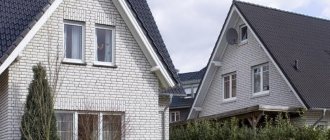Brick is often used in construction, despite the presence of more technologically advanced materials on the market, it does not yield to its position, thanks to a number of indicators and parameters, both operational and aesthetic. Both cottages and multi-story apartment buildings, as well as partition walls in apartments in high-rise buildings, use this type of building material. But before constructing such a structure, it is necessary to understand what the thickness of a brick wall can be in each specific case in order to ensure its functionality. Let's try to analyze all the subtleties and aspects of construction from this material in the article.
Types of brick partitions
The brickwork of internal partitions can be quite different in structure.
Here everything will depend on the desired weight of the structure. After all, a partition is the weight that the supporting structure must support. Schemes for laying partitions:
Edge laying
This option is suitable if your load-bearing floors cannot support a lot of weight.
In this option, the partition does not take up much space and, accordingly, usable area. Attention: It is worth saying that you should not do great heights right away. The brick will just move.
Brickwork in the brick floor This option is perfectly resistant to concrete floor slabs
Partitions are also made to insulate walls. Especially in panel houses. A wall with an air gap is placed where the insulation is placed. This is a fairly rigid and durable design. Brickwork of partitions 1 brick This option is quite durable and has a lot of weight. Not used that often. For this design, additional reinforcement of the floor slabs is done. Brickwork of partitions 1 2 bricks This structure is heavy and is made only in industrial premises. Calculations must be made here, because the weight is large and the supporting structures must support the weight.
Private construction of houses from reinforced concrete panels: stages and technology
When considering how panel houses are built, it is worth initially determining that this is a process associated with the use of special equipment.
Considering how panel houses are built, it is worth initially determining that this is a process associated with the use of special equipment. Even lightweight panels require lifts.
So, the stages of construction.
- Design. An important stage at which the process of developing estimate documentation occurs, the dimensions and contents of the house are determined, including not only external walls, but also internal partitions, ceilings, openings, etc.
The weight of the panels requires a solid foundation. The base may be tape, but it is very well buried
- Foundation. The weight of the panels requires a solid foundation. The base may be tape, but it is very well buried. A frame made of reinforcement must be built into the concrete pour. The height of the supporting base is on average 160-180 cm, of which at least 140 cm is located underground. The width of the foundation is from 40 cm. It is necessary to lay a sand cushion in the trench, which acts as drainage. The casting of the supporting base is made from a grade of cement not lower than M250. Ventilation holes are laid during the casting of the concrete base. Most often these are chokes located slightly above ground level.
- Installation of wall panels and ceilings. The construction of panel private houses is not carried out alone; this is not a brick. This requires equipment, so you must first prepare the foundation, bring in a certain amount of materials, and only then hire a lift. Construction is carried out quickly, so you won’t need to hire a crane for a long time.
Insulation and finishing - the final stage of construction
- Installation of walls. Everything is simple here, just look at the photos of projects and work sites. You will need a truck crane, a concrete mixer and a welding machine. The first one will lift the panels, the mixer will prepare a solution that will be useful for sealing joints, and the device will help connect the building elements into a single whole. Thanks to the accelerated process, financial costs are really low, even if the developer hires a team of professional craftsmen.
- The construction of the roof, as well as the floors, will not be difficult if you follow the project exactly. A powerful foundation will withstand any ceilings, which must also be solid. The rafter system is selected depending on the type of roof, and there are no restrictions here - look at photos of houses made of reinforced concrete panels and choose any roof. The advantage of the buildings is that almost any material is acceptable: from soft rolled sheets to iron.
- Insulation, finishing. Any house needs to be insulated. But it all depends on the type of slabs. If conventional reinforced concrete products are selected, a layer of insulation, waterproofing and final coating will not interfere. And, for example, if you use European slab elements, then they represent a kind of layered “pie” with insulation inside. First reinforced concrete, then a layer of insulation and finishing with plaster. At the same time, the owner will not have to pay extra for the interior finishing of the wall panels - it already exists! It will be enough to seal the seams and you can live.
As for the façade of the building, its decoration is in the hands of the owner. Very often, houses made of reinforced concrete are left in their original form. But if you want, you can use any materials - paint, plaster, tiles, cladding made of stone and other materials can be applied to the slabs
An important part of the construction work is that cottages built from reinforced concrete slabs do not require preliminary finishing or putty. They are ready to be decorated in any stylistic manner immediately after construction.
Recommendations from experts
Recently, many land owners prefer to build houses themselves, as this allows them to significantly save money. In order for the building to be durable and last for decades, it is necessary not only to draw up the project correctly, use high-quality building materials, but also to accurately calculate the thickness of the external and internal floors.
The following expert advice will help beginners with this.
The thickness of the walls consists of an inner, middle and outer part. Therefore, in order to correctly lay out the partitions, you need to pay special attention to the corners. To do this, a main point is selected and beacons are placed from it. The brick must be laid with dressing, using a certain pattern. After each laid row, the walls should be checked for verticality. If this is not done, then curvature may appear in the plane and the thickness will be unequal. It is recommended to calculate the width of the supporting structures based on the characteristics of the climatic zone in which the house is planned to be located. However, it cannot be less than 38 cm. In the northern regions, the thickness of the floors must be increased to 64 cm. To save material and obtain optimal wall thickness, it is necessary to lay out the blocks in a “well”. The result will be two partitions spaced apart from each other with a width of 140 to 270 cm. The space between them can be filled with sawdust, lightweight concrete or slag. Since the internal walls are made thinner than the external ones and do not require additional thermal insulation, they must be laid out to a thickness of at least 25 cm. In order for the loads on such structures to be distributed evenly, the joints of the internal and external walls should be reinforced with a special mesh or reinforcement every five rows of masonry. As for the walls, their thickness can be 51 cm and they are also reinforced. When laying 1.5 bricks, additional supports with a cross section of 38x38 cm are placed. For interior partitions that are not load-bearing and only zone the space, you can select any thickness. For example, between rooms and in the bathroom you can make masonry of 0.5 bricks, and for the pantry and other auxiliary rooms, “rib” masonry with a thickness of 65 mm is suitable. Such structures should be reinforced with wire every 2-3 rows of masonry. If you increase the thickness of the masonry, the room will acquire higher heat and sound insulation, but at the same time the cost of purchasing the material will increase. If external walls are erected “for jointing”, then their aesthetic appearance will depend on the composition and quality of the cement mortar. The thickness of all seams in this case should be the same, so the solution must be evenly filled with all voids and cavities
Since such structures are not very thick, insulating material and good finishing using facing slabs will help increase their thermal stability. When building walls, it is also important to remember that any deviation in their thickness can provoke unpredictable consequences. Therefore, during masonry it is impossible to allow changes in their height, as well as to reduce the distances between openings or increase their number.
You will learn about bricklaying a corner in one brick from the video below.
Builder tips
Experienced professionals can almost always give some useful tips for beginners, without which they would be guaranteed to make one of the common mistakes. For example, a fundamental point is the correct calculation of the foundation, taking into account the hydrogeology of the selected area. You should understand where the groundwater is located, how much there is, how much its quantity is affected by normal precipitation, and whether the soil under the future home is equally stable throughout the year. If this is not taken into account, then even a correctly calculated foundation, supposedly of sufficient strength, can “float”, especially if it is also made of brick and has limited bending strength. In such a situation, it will only contribute to the stretching of the walls above it and the bending of individual blocks, because cracks in the walls will appear too quickly and the building will not survive for long, posing a real threat to its inhabitants.
A separate point is the insulation of the external walls of the house or lining the main wall with facing materials. Many beginners do not take into account that it is necessary to leave a small gap between these two layers, because if there are temperature changes, condensation will still appear there, which can destroy the structure. If moisture gets inside, fungus can also penetrate there, which over time destroys the structure of building materials and increases the wear and tear of the house.
To avoid such phenomena, it is necessary to properly organize the ventilation of the space between the walls, for which special ventilation boxes are used. This device is made of very durable materials that can normally withstand any humidity and temperature changes without deformation. Thanks to them, thermoregulation inside the wall occurs naturally, and excess moisture gets out, so it does not accumulate inside and does not destroy the structure so much.
To learn how to properly make brickwork with your own hands, watch the following video.
The ratio of wall thickness and type of brick
Regarding the structure, bricks are divided into:
- corpulent (the most expensive option, characterized by high strength and thermal conductivity);
- hollow (this option is cheaper, because the products are less strong than solid ones, however, thanks to the air pockets in the voids, they retain heat better).
Types of bricks
Bricks come in different thicknesses, however, their length and width are always standard: 25x12 cm:
- single thickness 6.5 cm;
- half 1.2 cm thick;
- one and a half thickness 8.8 cm;
- double thickness 13.8 cm.
Typically, the greater the thickness of the wall, the larger the bricks chosen: one-and-a-half and double. The partitions inside the house are made of single and half bricks.
The minimum standard for the thickness of an internal brick wall is 1/20-1/25 of the floor height. For example, if the floor height is approximately 3 meters, then the thickness is at least 15 cm.
Material advantages
The key positive properties of brick are:
- high strength;
- aesthetic appeal;
- good sound insulation properties;
- fire safety;
- resistance to negative temperatures;
- environmental safety;
- versatility;
- long service life.
It is possible to build both one-story private houses and high-rise buildings from brick, the main thing is to correctly calculate the thickness of the outer wall masonry. The material, without changing its own properties and characteristics, can withstand loads that are a thousand times greater than its own weight. Buildings made from it can last hundreds of years if all technological nuances of masonry are followed,
How to find out which wall is load-bearing in a panel house
Panel houses are distinguished by the fact that they have special design codes, which can be used to understand how they were built. There are special databases in which, knowing the code, you can find a house plan and the required apartment, where it will be indicated which wall is load-bearing in it.
You can also find such a wall by measuring the thickness of surfaces. Non-load-bearing walls in panel houses usually have eighty millimeter or meter walls. And the underlying surface of interest has a thickness of one hundred and forty to two hundred millimeters.
If you decided to check the thickness of the wall before removing the finishing coating, then it can affect the obtained indicators; they take about fifty millimeters.
You can find such a wall by measuring the thickness of the surfaces.
Internal load-bearing walls
Buildings with a length or width of more than five and a half meters are separated along the long side by internal load-bearing walls. They are used for end support of the ceilings or coverings of the structure.
The thickness of internal brick walls is made smaller than external ones, because insulation is not required here, but not less than 250 mm (brick laying). All load-bearing walls, both external and internal, are interconnected and, along with the foundation and roof, form a single structure - the skeleton of the building. All loads acting on the structure are evenly distributed over its area. The junctions of the external and internal walls are reinforced with meshes or separate reinforcement through 5 rows of masonry. The walls are at least 510 mm wide and they are also reinforced. If it is necessary to install pillars as load-bearing supports, then the cross-section of the structures must be at least 380x380 mm (one and a half brick masonry). They are also reinforced with 3–6 mm wire every 5 rows along the height of the masonry.
What indicators are taken into account when calculating?
Development of a construction project involves entering all the data into drawings, on the basis of which a cost estimate is developed.
To calculate the amount of brick for walls you need to know several basic indicators:
- Area of constructed surfaces. It is measured by multiplying the length of external or internal walls by the height of the ceiling to the floors. The area of window and door openings is subtracted from the resulting indicator. This is the initial indicator from which the volume of the masonry is calculated.
- Type of brick. For the walls of buildings, single, one-and-a-half and double types are used, which have a discrepancy in the height of the product. The brick is produced in a length of 25 cm and a width of 12 cm, but has different thickness parameters. Single - 6.5 cm, one-and-a-half - 8.8 cm and double - 13.8 cm. Facades made of thinner bricks look neater and more beautiful, but erecting walls of one-and-a-half or double thickness allows you to reduce construction time and save on mortar .
- Thickness of brickwork. Depends on the regional affiliation of the object. The optimal wall thickness for the middle zone is considered to be 2-2.5 bricks. The thickness of the wall, based on the type of masonry, is calculated: 1 brick - 25 cm, 1.5 - 38 cm, 2 - 51 cm, 2.5 - 64 cm.
Also, when making calculations, it is necessary to take into account the thickness of the seam, which can be 10-15 mm. Without taking this indicator into account, the discrepancy in calculations of the required amount will be 20-25%. Architectural features of the project and the complexity of the wall relief can increase material consumption by up to 30% per 1 m3.
According to building codes, when constructing walls from piece elements, a horizontal joint thickness of 12 mm and a vertical joint of 10 mm is allowed. Deviations from the norm are unacceptable and must be constantly monitored.
When saving mortar, it is difficult for builders to maintain the level when the brick is uneven. Increasing the thickness of the mortar saves building materials, but leads to a loss of strength of the entire structure.
Example
It is necessary to make a calculation for a house with 10x10 m external walls with a ceiling height of 3 m. How to calculate how many bricks are needed for masonry:
- the perimeter length (10x4=40 m) is multiplied by the height to the ceiling (40x3=120 sq. m) - this will be the initial indicator;
- The brickwork area is 120 sq. m. from it you need to subtract the area of the windows and the front door (1x1.2x3) + (1.2x1.5x1) = 5.4 sq. m. m, for which no material is consumed;
- calculation of the total volume of masonry depending on the thickness of the wall 1/1.5/2/2.5 bricks (120-5.4 x brick width 0.25/0.38/0.52/0.64) = 28.65/ 43.55/59.6/73.34 cu. m;
- calculation of the required amount of material is made by dividing the total volume of the masonry by the volume of a unit of brick;
- when taking into account the thickness of mortar joints, it is necessary to add an average of 12 mm to the height of the brick;
- As a result, we get the average amount of brick required to build the walls of a given house.
| Type of masonry | Brick type | Number of blocks |
| 2 bricks | 1 | 204 |
| 1,5 | 156 | |
| 2 | 104 | |
| 2.5 bricks | 1 | 255 |
| 1,5 | 195 | |
| 2 | 130 |
It is necessary to add 5-10% to the calculations for battle, defects and architectural features of the project.
For the convenience of consumers, there are online calculators on the websites of construction companies that will make calculations when entering data. There you can also estimate the required volume of masonry mortar, which will help when purchasing materials and estimating the costs of building a house.
Regulatory documents
General requirements for the thickness of panel wall structures are regulated by the following technical documents, defining the basic conditions :
- GOST – monolithic wall panels.
- GOST 31310-2015 – reinforced concrete panels with three layers and insulation.
- GOST 11024-84 – external monolithic panels used for residential multi-apartment buildings.
- GOST 11118-73 – external walls of public monolithic buildings.
- GOST 33126-2014 – expanded clay concrete wall blocks.
- GOST 32603-2012 – sandwich panels.
- SP 31-105-2002 – private houses with wooden panels.
- GOST 33929-2016 – polystyrene concrete wall structures.
Monolithic panels have the most GOST standards. This is due to the fact that secondary multi-apartment housing, built from the beginning of the pre-war years to the 80s, was built in large quantities throughout the entire territory of the Soviet Union. If we draw a general conclusion on the thickness of the walls for all panels, the structural thickness of the products can have different sizes - 40, 60, 80, 140, etc. (mm).
When determining the thickness of a wall structure, be sure to pay attention to the dimensions of door and window openings. GOSTs are used here :
- 14624-69;
- 6629-74;
- 11214-78.
The documents indicate the requirements for their thickness, which directly applies to the wall structure where windows and doors will be installed.
How to detect load-bearing walls?
In some cases, identifying such a load-bearing wall in a residential area does not cause any particular difficulties, but in other apartments this operation is not so simple. The easiest way out of the situation is to read the construction documentation - the technical passport, which all owners of privatized apartments have. However, not everyone will be able to understand the drawings, since at least minimal construction experience is required, as well as the ability to understand such documentation.
Sometimes the task is simplified, since it is possible to determine the load-bearing wall by its location. All external partitions of the building are considered as such, as well as those that open onto the landing. The walls bordering neighboring apartments are, in most cases, load-bearing structures.
Thickness and material will help determine what you are looking for. If it is a brick, then the thickness of the load-bearing wall must be at least 380 mm, for a reinforced concrete structure - 140-200 mm, for monolithic walls - from 200 or more. The location of the floor slabs can also answer the question, since all partitions located perpendicular to them are load-bearing by definition. However, this rule also has exceptions. These include, for example, buildings built in the Czech Republic.
These are just the basics, they can tell you where you can find such structures, but for a detailed examination it is better to go on a trip to all types of multi-story buildings.
Panel construction – a legacy of the past or a technology of the future?
The first panel houses appeared in the middle of the last century. Let's face it, they didn't shine with their level of comfort. But since then, technology has moved forward. Concrete blocks were replaced by sandwich structures, which made it possible to diversify the appearance of buildings, improve the layout of apartments, and their noise and heat insulation qualities.
✓
Relatively low price, which is explained by the low cost of materials and the ability to mechanize labor
✓
Construction speed. A developer spends an average of 6 to 12 months on the construction of a panel multi-storey building without underground parking.
✓
As in monolithic houses, initial repairs do not require much effort.
In terms of other parameters, apartments in a panel house, alas, lose:
✘
Developers claim a service life of 40–50 years
✘
The layout is only standard, since almost all walls are load-bearing
✘
Sound insulation - often interior walls are made of panels of small thickness, and you may become an unwitting witness to the privacy of your neighbors
✘
Insufficient thermal insulation, which can be associated both with the design and with the developer’s dishonesty. In such houses, residents often use electric radiators for heating in winter, and they have to pay more for light.
What can you do and what can’t you do?
The question of how to determine a load-bearing wall arises only for those who are planning to improve something in the apartment - to destroy it, in order to then gain more space for creative activity.
Therefore, it is better to immediately write that complete dismantling of the partition, on which a serious load is placed, is impossible. The likely outcome is the destruction of the building. Any independent redevelopment requires permission from higher authorities. If it comes to the demolition (relocation) of a load-bearing wall, then in the event of uncoordinated actions to restore it, extreme owners will pay out of their own pockets. Most likely, there will be a fine. Other possible consequences are a summons to court, confiscation of an apartment.
If no drastic actions are planned, and we are just talking about an opening, then such actions are quite acceptable. But only if the redevelopment is approved, and an architect bureau will take on the creation of the project.
Chasing of load-bearing walls is prohibited, so it will not be possible to hide communications in such partitions. Wiring communications (ventilation, water supply, sewerage) through main walls, on the contrary, is possible.
The thickness of the wall is one and a half bricks and its features
A wall thickness of one and a half bricks is another common masonry used in the construction of buildings. The bricks are laid from the corners, the first bricks in the row must be perpendicular to each other. The thickness of a brick wall of one and a half bricks is equal to 38 cm of masonry.
Control over the correct laying of bricks can be done using a special construction corner.
The laying of the first row in this form is carried out using a cord, which is stretched in height between the first and second bricks. The bonded surface of the bricks is located on the outer side, and the bricks of the first row of the inner side of the masonry are directed with the tongue part inward.
The bricks in the next row are laid in the opposite order. Thus, a mirror image of the bricks in the first row is formed. The inner side of the wall is eventually laid in brick, and the outer side in half a brick.
The use of one and a half brick masonry has become widespread due to the required structural strength. The vertical seams do not match anywhere and end up covered by the surface of other bricks.
When doing masonry, the width of the joints is a very important indicator. If the size of the seams increases, it means that there is a deviation from the vertical or from the direction of the entire masonry.
Construction of the foundation of a monolithic house
In the construction of monolithic houses, foundations are used that differ in load-bearing capacity, installation complexity and cost. Private monolithic construction offers three main options for foundation construction: strip, slab and pile.
Strip foundations
A prefabricated strip foundation is made of concrete blocks bound with cement mortar. For all its positive qualities, a prefabricated foundation is inferior to a monolithic one.
Features of installing a foundation of this type:
- We lay a sand “cushion” 15-20 cm thick into the finished trench. Using a crane, we install the blocks in the trench, guided by a pre-marked marking line.
- We seal the vertical seams between the blocks with cement mortar prepared in a ratio of 1:3 - in this case, it is recommended to use M-400 cement (the most common and popular brand of cement).
- We tie the loops to which the crane hooks clung with wire and bend them.
- We lay cement mortar on the upper surface of the first row of blocks.
- We install the second row following the same procedure.
- Along the last row we install a reinforced concrete belt to strengthen the foundation. The upper level of the monolithic belt, if possible, must be arranged strictly horizontally.
Slab foundation
Slab foundation for a monolithic house
In construction, two technologies for constructing slab foundations are used: monolithic and prefabricated. Prefabricated slab foundations are used for buildings with complex configurations and large areas. In the construction of residential buildings, reinforced monolithic slabs are mainly used.
A foundation in the form of a monolithic slab (slab) is not as in demand as a strip foundation, but under certain operating conditions it is difficult to find a replacement.
Safety precautions
When performing work on the construction of external and internal load-bearing walls and partitions, strict compliance with the requirements of labor safety measures set out in SNiP 12-04-2002 (section 9) and SNiP 12-03-2001 Labor safety in construction is necessary. Part 1. General requirements.
Lifting building materials and products to the floor, moving them to workplaces must be carried out using lifting means and packaging means to prevent them from falling and being damaged.
Workers receiving loads at masons' workplaces must be trained and have a slinger's certificate. A stable radiotelephone connection must be established between the workers and the tower crane operator.
Before installing carpentry, all window and door openings in the external walls being constructed must be fenced or closed with safety shields (grids).
Prohibited
when laying masonry, stand on it with your feet or lean on it.
The flooring used must be of stock production only. It is prohibited
to use pallets, boxes, containers, as well as other objects not intended for these purposes as scaffolding .
The gap between the wall (partition) being erected and the working floor should not exceed 50 mm. The flooring of working scaffolds must be regularly (at least 2 times per shift) cleared of debris. Protective canopies with a plan size of at least 2 x 2 m must be installed over the working entrances to the section. The suspended scaffolds used must be of an inventory type only and subject to periodic inspection.
In areas of masonry of external walls, external inventory protective canopies must be installed in the form of flooring on brackets. The brackets are hung on steel clamp hooks attached to the wall being built along the course of its laying. The first row of protective canopies is installed at around 3.300, and is maintained until the completion of the construction of the external walls. The second row of protective canopies is installed on the external walls and is rearranged along the course of the masonry every 6 m. It is allowed to use the second row of flooring made of mesh materials with a cell size of no more than 50 x 50 mm.
All construction waste generated during the work must be collected in a special container (garbage container) and, as it accumulates, removed from the floor by tower crane for removal off the construction site. Removing construction and household waste by throwing it down through window or door openings or from balcony slabs is prohibited.
Quality control of brickwork work
— acceptance of previously completed installation work preceding brickwork
— quality control of building materials and products used for masonry and mounted lintels
— control of production operations related to the production of stone works and laying of lintels over openings
— acceptance control of completed stone work with execution of inspection reports for hidden work.
Acceptance of previously completed work prior to the construction of external and internal load-bearing walls and partitions should be carried out in accordance with the requirements of Section 2, paragraphs 2.111...2.113 of SNiP 3.03.01-87 and working drawings of the project.
Control of production operations is carried out according to the scheme of operational quality control of stone work and work on the installation of lintels over window and door openings of walls and partitions.
What factors need to be considered when choosing the type of masonry?
When determining how thick a wall should be, it is advisable to focus on the following points:
Estimated load. This is a determining factor, including the number of storeys of the building, as well as its functional purpose. Climatic nuances
The building being constructed must provide comfortable conditions for people, this is especially important for a winter home where people live permanently. The thickness is considered sufficient if the walls do not freeze. Accepted Standards
When calculating the thickness of walls, it is important to focus on the standards prescribed in the current GOST. Only under this condition will the house be safe to live in. External attractiveness. The aesthetic component is very important for an external wall, so it cannot be ignored either. Thin masonry looks most preferable, but is not always acceptable.
We demolish walls during redevelopment, what can be demolished and what cannot
Many people, especially those living in Khrushchev-era apartment buildings, try to remodel their small and uncomfortable apartments using redevelopment. But it’s one thing to do it in an individual building, and quite another to change a doorway or move a partition in a high-rise building, where almost every wall is load-bearing. All this ensures the safety of residents in combination with the entire technical design of the house.
What is redevelopment? According to the Housing Code, this concept includes all changes in the configuration of the apartment that require inclusion in the technical passport. This:
- changing the location of load-bearing walls and partitions,
- relocation of window and door openings,
- re-equipment of vestibules and dark storage rooms,
- arrangement of internal stairs,
- refurbishment of bathrooms,
- division of large rooms,
- expansion of living space due to household premises,
- glazing of a balcony or loggia,
- replacing gas stoves with electric ones,
- moving a bathroom, kitchen or toilet.
All these types of changes in the apartment relate to redevelopment and require approval from the relevant authorities.
What cannot be demolished: a load-bearing wall
Most often, redevelopment involves the demolition of interior partitions. But not everyone knows which walls can be touched and which ones cannot. Reckless demolition of structures leads to a change in the action of forces on the remaining surfaces and rooms located below.
In addition, ceilings left without support may not withstand the load and collapse at any time.
Since, in addition to separating different rooms, the wall elements serve as ceiling supports for all similar structural elements located above.
The main (load-bearing) walls in practice are located perpendicular to the floor beams. If it is made of concrete slabs, then their ends rest on the surface of the supporting structure. Usually these are walls between apartments and blocks, or external ones. As a rule, only partitions are equipped inside the apartment.
How to find out which wall is load-bearing?
Is it possible to determine the purpose of the wall yourself? Certainly. By its thickness or the material from which it is built. In panel-type houses, internal blocks have a thickness of up to 120 mm. Therefore, they can be considered partitions (their thickness ranges from 80-120 mm).
The load-bearing surface must have a thickness of at least 140 mm. Most often, in such houses, the external walls are made with a thickness of 200 mm. In brick houses, external, load-bearing structures have a thickness of 380 mm or more, inter-apartment structures - 250 mm, and partitions - 120 or 80 mm.
The material most often used for load-bearing walls in panel houses is wall or inter-apartment blocks made of reinforced concrete with various additives to lighten the structure and increase thermal protection. Internal partitions in 90% of panel houses are made of gypsum concrete panels. In brick buildings, the main material for all walls is red and sand-lime brick, which differ in size. Gypsum concrete panels can also be used as partitions.
Of course, no one is going to demolish the outer walls, but the partitions can be removed by obtaining the appropriate permission. To accurately determine which wall is load-bearing, it is best to use BTI data - a detailed floor plan. There, all main walls are marked with thicker lines, and partitions that do not have such functions are marked with thinner lines.
What is needed for demolition?
In any case, before starting work on demolishing a particular wall and moving it, you need to consult a qualified specialist. As well as a full calculation that takes into account the distribution of loads that must be transferred from old structures to newly erected ones.
In addition, you may have to change the power supply circuit. In addition, it must be borne in mind that uncoordinated demolition of the walls of the premises may prevent its sale or the preparation of donation documents, etc. But that’s not all.
Such actions are considered illegal and entail fines, summonses to court, and can even lead to confiscation of the apartment.
Therefore, approval of the redevelopment project is necessary in any case. What is needed for that?
- A plan developed by the BTI service specifically for this type of redevelopment.
- Drawing up a technical report for the demolition of the wall.
- Obtaining a positive conclusion from the housing inspection at the place of registration.
Display all materials with the tag:
- construction works
- organizational matters
Determination by location of vertical structure
NS are usually located at right angles to the floor beams. If the floor is made of concrete slabs, then their ends should lie on the supporting structure. Basically, these are external, inter-apartment and inter-block walls.
The base of the room (its box) is surrounded by supporting planes. These include:
- External walls facing the street (yard). Some people mistakenly believe that the walls in the yard are not supporting - this is a big misconception.
- Structures that enclose the apartment from the staircase and elevator space.
- Walls between neighboring apartments. But we cannot confidently assume that the interior planes are partitions. In some panel houses with 5 floors, load-bearing walls are even located between rooms.
Partitions cannot serve as an accurate guide. A person who is not a specialist in this field will not be able to accurately determine the NS without dismantling the coating.
Thermal conductivity of aerated concrete
When constructing residential buildings, their reliability and durability come first. The next parameter is their ability to withstand environmental influences, heat and cold. If aerated concrete is chosen for external load-bearing structures, the thickness of the building walls determines the stability of the internal microclimate in the premises.
Thermal conductivity refers to the ability of blocks to transfer heat throughout their volume from the outer edge to the inner one. To calculate the indicators, the amount of heat in watts passing through 1 m³ of substance in 1 hour is taken. The lower this number, the better the insulating qualities of the material.
The average value for porous blocks is 0.10-0.15 W/(m×°C), and for bricks - 0.40-0.50 W/(m×°C). It has been experimentally established that 1 cm of gas silicate material neutralizes 1 °C of cold.
So, in order to calculate how thick aerated concrete walls should be, you should take as a basis the following correspondences of the thickness of the blocks in cm and their thermal conductivity indicators:
- 12 — 1,15;
- 18 — 0,75;
- 20 — 0,70;
- 24 — 0,57;
- 30 — 0,45;
- 36 — 0,39;
- 40 — 0,35;
- 48 — 0,29;
- 60 — 0,22;
- 72 — 0,19.
Large sizes are rarely used and are used only in industrial construction for the construction of outbuildings, where it is necessary to maintain a constant and stable temperature.
Thermal insulation protection
Some insulation materials require protection from getting wet, blowing or, for example, direct sunlight. Some of these tasks may be assigned to the finishing layer, but the main protection is provided by special membrane materials.
One of the most commonly used insulation materials in Canadian frames, stone wool, has the ability to sharply reduce the resistance to heat transfer when wet. The source of moisture can be precipitation or condensation of water vapor. In the first case, special synthetic burlap is used that allows air and water vapor to pass through, but retains water droplets.
The penetration of steam from the inside cannot be completely limited, because the building must carry out natural gas exchange with the environment. However, it is possible to limit the amount of water vapor to such a level that it is not enough to raise the relative humidity in the cooled indoor air to 85–90%. Typically, such a calculation is carried out for the point of separation of the rows of a frame or supporting system with external insulation. However, the same method can also be used to calculate layer-by-layer the dew point displacement throughout the year inside homogeneous walls.
What kind of walls are there in a building?
Characteristics do not affect the distribution of walls into groups
The location of the element and its role in the arrangement of the building are important. These points are studied before the installation of floors begins.
Technical data sheets confirm the presence of the following varieties:
- Partitions. Vertical structures inside, for fencing. With support in the form of ceilings, to separate adjacent rooms. The simplest definition.
- Curtain walls. Usually they become external if the floor does not reach 6 meters in height, allowing support on floors within the same structure. Protects the building from environmental influences.
- Self-supporting walls. With fencing function, also in a vertical position. The weight is completely transferred to the side of the foundation. Serve for protection from the environment, only in the case of interior spaces. This is the main difference.
- Bearing wall. Towards a vertical plane, with the main functions of a load-bearing and enclosing nature. The foundation will not only become a support for it, it will transfer the entire load to it with its own weight and ceilings. Provides separation of adjacent buildings along with protection. Curtain walls are elements that differ from this group.
The location of the element and its role in the arrangement of the building are important
Load-bearing, self-supporting and load-bearing walls - what's the difference?
Self-supporting walls are small in thickness compared to their analogues. Thanks to this, the construction of the structure requires less material. The standard range is from 50 to 380 mm, depending on the source material for construction. The panel house is no exception.
Non-load-bearing enclosing structures can also be erected when it comes to the construction of different types of buildings. Elements with a lower location do not transfer the load to the structures. Such products are also called hinged. For them, construction always takes place within one floor. But structures become self-supporting if the floor height exceeds 6 meters. At the same time, approaches to design and actual construction are changing.
If the wall is self-supporting, it is a fence located outside. Provides additional protection by being adjacent to the building from the main frame. The fastening goes from the side, along the entire perimeter of the floor. Self-supporting enclosing structures can consist of one layer or several layers at once. When placed inside buildings, the main purpose becomes the function of partitions. For self-supporting walls it is the same, only with some adjustments.
Self-supporting walls are small in thickness compared to their analogues.
General requirements
Internal walls and partitions are the main internal vertical enclosing structures in buildings. In addition, internal vertical enclosing structures form structural elements combined with engineering equipment: sanitary cabins, ventilation blocks and shafts, elevator shafts, etc. The corresponding sections are devoted to the consideration of these structural elements. (see Categories)
Internal walls perform enclosing and load-bearing functions in the building, partitions are only enclosing. Wall and partition structures must meet regulatory requirements for strength, stability, fire resistance, sound insulation, be vapor and gas tight, easily erected and easy to clean. Partitions and walls of wet rooms must also be waterproof and waterproof.
The design of walls and partitions, the choice of their structure is carried out taking into account the listed, as well as economic requirements, since the construction of walls and partitions reduces up to 20% of the cost of building structures and 15% of labor costs for its construction.
The level of regulatory requirements for the strength and fire resistance of wall and partition structures varies due to the different roles of these structures in the static operation of buildings.
The general enclosing function of internal walls and partitions is to provide sound insulation from airborne noise. In this regard, the level of requirements for the soundproofing qualities of these structures coincides and depends not on their static role in the building, but on their location in it. For inter-apartment and intersection walls and partitions, for fences separating living rooms from staircases and elevator halls, the insulation index required by the chapter SNiP “Noise Protection” must be at least 50 dB, for interior walls - 41, for walls and partitions separating living rooms and sanitary premises of the apartment - 45, and for fences between living rooms and built-in shops or cafes - 55 and 60 dB, respectively.
To ensure sound insulation, acoustically homogeneous or heterogeneous structures are used. Massive single-layer enclosing structures with a solid or multi-hollow section are used as acoustically homogeneous ones; double walls and partitions, walls with a flexible screen, and multi-layer lightweight partitions are used as heterogeneous ones. The sound insulation method is chosen based on the appropriate use of the properties of the materials used.
